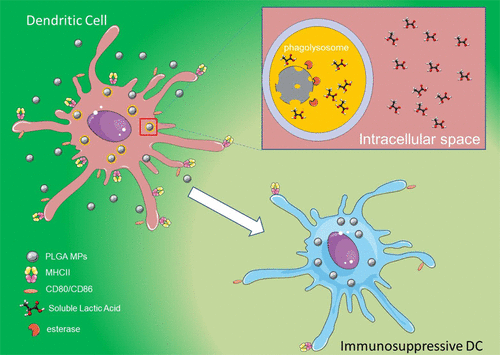当前位置:
X-MOL 学术
›
ACS Biomater. Sci. Eng.
›
论文详情
Our official English website, www.x-mol.net, welcomes your
feedback! (Note: you will need to create a separate account there.)
Latent, Immunosuppressive Nature of Poly(lactic-co-glycolic acid) Microparticles
ACS Biomaterials Science & Engineering ( IF 5.4 ) Pub Date : 2018-02-03 00:00:00 , DOI: 10.1021/acsbiomaterials.7b00831 Riley P Allen 1 , Amir Bolandparvaz 1 , Jeffrey A Ma 1 , Vishal A Manickam 1 , Jamal S Lewis 1
ACS Biomaterials Science & Engineering ( IF 5.4 ) Pub Date : 2018-02-03 00:00:00 , DOI: 10.1021/acsbiomaterials.7b00831 Riley P Allen 1 , Amir Bolandparvaz 1 , Jeffrey A Ma 1 , Vishal A Manickam 1 , Jamal S Lewis 1
Affiliation

|
Use of biomaterials to spatiotemporally control the activation of immune cells is at the forefront of biomedical engineering research. As more biomaterial strategies are employed for immunomodulation, understanding the immunogenicity of biodegradable materials and their byproducts is paramount in tailoring systems for immune activation or suppression. Poly(d,l-lactic-co-glycolic acid) (PLGA), one of the most commonly studied polymers in tissue engineering and drug delivery, has been previously described on one hand as an immune adjuvant, and on the other as a nonactivating material. In this study, the effect of PLGA microparticles (MPs) on the maturation status of murine bone marrow-derived dendritic cells (DCs), the primary initiators of adaptive immunity, was investigated to decipher the immunomodulatory properties of this biomaterial. Treatment of bone marrow-derived DCs from C57BL/6 mice with PLGA MPs led to a time dependent decrease in the maturation level of these cells, as quantified by decreased expression of the positive stimulatory molecules MHCII, CD80, and CD86 as well as the ability to resist maturation following challenge with lipopolysaccharide (LPS). Moreover, this immunosuppression was dependent on the molecular weight of the PLGA used to fabricate the MPs, as higher molecular weight polymers required longer incubation to produce comparable dampening of maturation molecules. These phenomena were correlated to an increase in lactic acid both intracellularly and extracellularly during DC/PLGA MP coculture, which is postulated to be the primary agent behind the observed immune inhibition. This hypothesis is supported by our results demonstrating that resistance to LPS stimulation may be due to the ability of PLGA MP-derived lactic acid to inhibit the phosphorylation of TAK1 and therefore prevent NF-κB activation. This work is significant as it begins to elucidate how PLGA, a prominent biomaterial with broad applications ranging from tissue engineering to pharmaceutics, could modulate the local immune environment and offers insight on engineering PLGA to exploit its evolving immunogenicity.
中文翻译:

聚乳酸-乙醇酸微粒的潜在免疫抑制性质
利用生物材料时空控制免疫细胞的激活是生物医学工程研究的前沿。随着越来越多的生物材料策略被用于免疫调节,了解可生物降解材料及其副产物的免疫原性对于定制免疫激活或抑制系统至关重要。聚(d,l-乳酸-乙醇酸)(PLGA)是组织工程和药物递送中最常研究的聚合物之一,之前已被描述为一方面作为免疫佐剂,另一方面作为非活化剂。材料。在本研究中,研究了 PLGA 微粒(MP)对小鼠骨髓来源的树突细胞(DC)(适应性免疫的主要启动子)成熟状态的影响,以破译这种生物材料的免疫调节特性。用 PLGA MP 处理来自 C57BL/6 小鼠的骨髓来源的 DC,导致这些细胞的成熟水平出现时间依赖性下降,这通过阳性刺激分子 MHCII、CD80 和 CD86 的表达以及能力的下降来量化。抵抗脂多糖(LPS)挑战后的成熟。此外,这种免疫抑制取决于用于制造 MP 的 PLGA 的分子量,因为较高分子量的聚合物需要更长的孵育时间才能产生相当的成熟分子抑制。这些现象与 DC/PLGA MP 共培养期间细胞内和细胞外乳酸的增加有关,推测乳酸是观察到的免疫抑制背后的主要因素。我们的结果支持了这一假设,证明对 LPS 刺激的抵抗可能是由于 PLGA MP 衍生的乳酸能够抑制 TAK1 磷酸化,从而阻止 NF-κB 激活。这项工作意义重大,因为它开始阐明 PLGA(一种具有从组织工程到制药等广泛应用的著名生物材料)如何调节局部免疫环境,并提供对工程 PLGA 以利用其不断发展的免疫原性的见解。
更新日期:2018-02-03
中文翻译:

聚乳酸-乙醇酸微粒的潜在免疫抑制性质
利用生物材料时空控制免疫细胞的激活是生物医学工程研究的前沿。随着越来越多的生物材料策略被用于免疫调节,了解可生物降解材料及其副产物的免疫原性对于定制免疫激活或抑制系统至关重要。聚(d,l-乳酸-乙醇酸)(PLGA)是组织工程和药物递送中最常研究的聚合物之一,之前已被描述为一方面作为免疫佐剂,另一方面作为非活化剂。材料。在本研究中,研究了 PLGA 微粒(MP)对小鼠骨髓来源的树突细胞(DC)(适应性免疫的主要启动子)成熟状态的影响,以破译这种生物材料的免疫调节特性。用 PLGA MP 处理来自 C57BL/6 小鼠的骨髓来源的 DC,导致这些细胞的成熟水平出现时间依赖性下降,这通过阳性刺激分子 MHCII、CD80 和 CD86 的表达以及能力的下降来量化。抵抗脂多糖(LPS)挑战后的成熟。此外,这种免疫抑制取决于用于制造 MP 的 PLGA 的分子量,因为较高分子量的聚合物需要更长的孵育时间才能产生相当的成熟分子抑制。这些现象与 DC/PLGA MP 共培养期间细胞内和细胞外乳酸的增加有关,推测乳酸是观察到的免疫抑制背后的主要因素。我们的结果支持了这一假设,证明对 LPS 刺激的抵抗可能是由于 PLGA MP 衍生的乳酸能够抑制 TAK1 磷酸化,从而阻止 NF-κB 激活。这项工作意义重大,因为它开始阐明 PLGA(一种具有从组织工程到制药等广泛应用的著名生物材料)如何调节局部免疫环境,并提供对工程 PLGA 以利用其不断发展的免疫原性的见解。










































 京公网安备 11010802027423号
京公网安备 11010802027423号